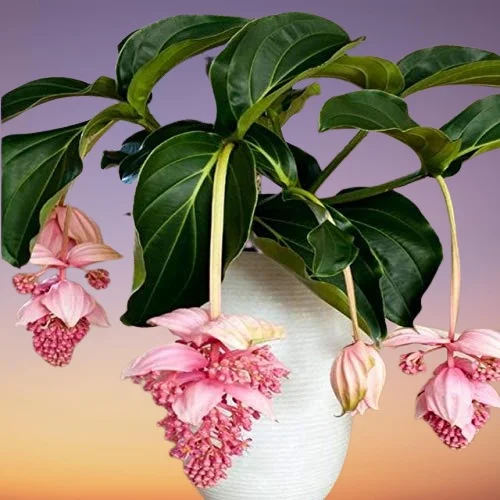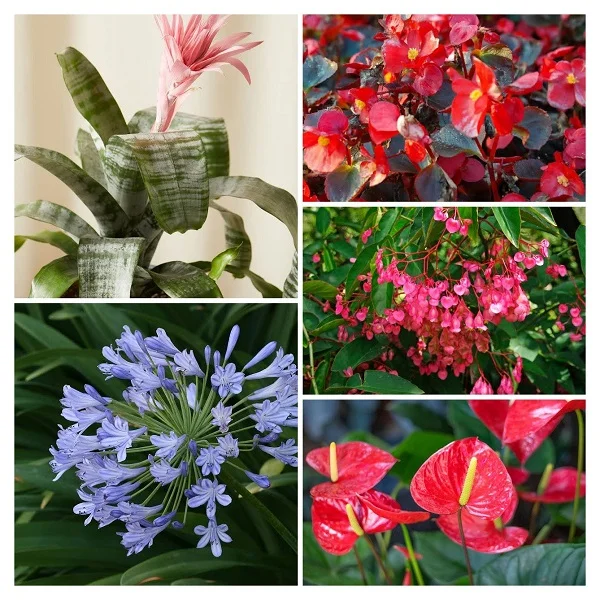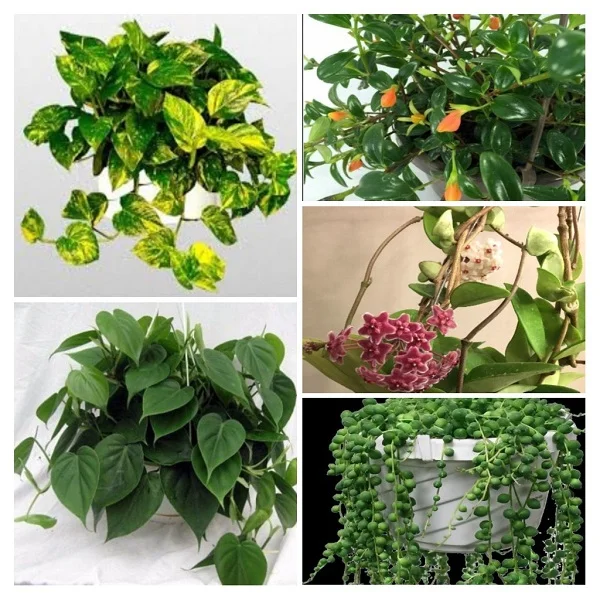How to Grow and Care for Medinilla magnifica (Rose Grape Plant) Indoors
Some links in this post may be affiliate links
Rose Grape Plant (Medinilla magnifica) flourishes in bright indirect light, moderate warmth, above average humidity and moderately moist, rich, well-drained soil coupled with fortnightly feeding in the growing season.
Medinilla magnifica will blossom indoors with the right care. In this guide, we will cover light, watering, soil requirements, and solutions to common growing problems to help you keep your Rose Grape Plant thriving indoors.
Medinilla magnifica also called Showy Medinilla, Pink Lantern or Philippines Orchid bears spectacular pendant rosy-pink flower-heads and is a great addition to any plant collection.
The large leathery oval leaves are prominently veined with wavy edges and are borne in pairs. The stems are winged.
Showy Medinilla can be grown in a hanging basket or on a pedestal where the large, pendant flowers can beautifully hang downwards placing it among the best flowering plants for a hanging basket.
Due to its requirement for high humidity and warmth, it is not easy to grow under room conditions. However, it is a magnificent flowering houseplant if the requirements are met.

Botanical name: Medinilla magnifica
Family: Melastomataceae
Common names: Rose Grape, Showy Medinilla, Philippines Orchid, Pink Lantern
Origin
Rose Grape Plant is native to the Philippines where it grows as an epiphyte on trees. Medinilla magnifica is named after José de Medinillay Pineda, who was governor of Mauritius in 1820. The species name 'magnifica' means 'magnificent', 'great', 'eminent', or 'distinguished'.
Flower
The inflorescences in Medinilla magnifica are arching panicles of pink flowers, with showy pink basal bracts and are about 1.5 feet long.
How big do Medinilla magnifica get?
Medinilla magnifica is a slow-growing tropical plant which grows to a height of about 2-3 feet and a spread of about 2-3 feet. The leaves are about 1 foot long.
Is Medinilla magnifica poisonous?
Medinilla magnifica is non-toxic to both humans and pets. It is among the pet-fiendly plants making it safe for cats, dogs and other pests.
Where to Buy
Rose Grape Plants are a great addition to your plant collection. You may obtain these plants online from Etsy (Link to Etsy).

Caring for Medinilla magnifica indoors
How do you take care of Medinilla magnifica?
Caring for Medinilla magnifica entails giving it bright indirect light (filterd light), moderate warmth of 16-240C, humidity of 60-70% and moderately moist, fertile, well-drained potting soil coupled with fortnightly feeding in the growing season.
Rose Grape Plant care requires regular pruning to keep it neat as well as encourage a bushy growth. Repotting is only necessary when it becomes pot-bound. Keep reading for more on the best growing conditions and how to achieve them.
Watering
Water your Medinilla magnifica liberally during the growing season and allow the top 2-3 inches of soil to dry out between waterings. Keep the soil moderately moist and avoid overwatering to prevent yellowing leaves and mushy stems.
Cut down watering in the cold season (fall and winter) to maintain the soil barely moist as growth is minimal at this time. However, do not allow the soil to dry out completely as it can result in wilting and drooping leaves, and dry, crispy leaf edges.
Use room temperature water to avoid shocking the roots of this tropical plant which can cause slow growth and leaf drop.
Refrain from watering with chlorinated water as it causes brown leaf tips and edges. Instead water with rain water or filtered water.
Pot your plant in a pot that has a drainage hole to prevent the soil from getting soggy as it can lead to root-rot and eventual death of the plant.
Pro tip: Avoid wetting the foliage during watering to discourage fungal diseases.
Light requirements
Rose Grape Plant prefers bright indirect light (dappled light). Keep it away from direct sunshine to avoid scorching of the leaves.
Too little light will lead to leggy growth and fewer flowers. Therefore, if you do not have adequate light in your home, consider instaling a grow light to supplement it.
Pro tip: Regularly rotate the pot to ensure that the plant receives light on all sides for balanced growth and also prevent legginess.
Temperature and Humidity
Medinilla magnifica thrives in warm temperatures of 16-240C. A room temperature that is comfortable for you is ideal for this plant. Keep it away from drafts to prevent leaf curl and leaf fall.
Rose Grape Plant requires a humidity of 60-70% to thrive. Low humidity will result in brown leaf tips and edges. To elevate humidity, set the pot on a wet pebble tray, use a cool mist humidifier or grow the plant in a well-lit bathroom and other humid areas in the home. Do not mist as it promotes fungal diseases.
Pro tip: Ensure that there is good air circulation for your plant to minimize fungal diseases infestations.
Fertilizer
Feed your Rose Grape Plant with a Phosphorous-rich, water-soluble fertilizer every 2-3 weeks during the growing season to promote blooming.
Avoid too much fertilizer as it may result in leggy growth. Do not feed with a Nitrogen-rich fertilizer as it can lead to excessive foliage growth at the expense of flowers.
Stop feeding in the cold season (fall and winter) as growth is reduced at this time, therefore, the plant does not need it. Feeding at this time can result in fertilizer burn and death of the plant.
Potting Medium
What kind of soil does a Medinilla magnifica need?
The best soil for Medinilla magnifica should be a well-draining, aerated soil that retains moisture without becoming soggy. A mix made up of 50% orchid mix or peat-based potting soil, 30% perlite or sand (for aeration) and 20% bark or coco coir (for moisture retention) is ideal for this plant.
Repotting
Repot your Rose Grape Plant at the beginning of the growing season into a pot one size larger than the previous one only when the plant becomes pot-bound.
Make sure that the pot has a drainage hole and the soil is well-draining to prevent root-rot. Take a look at these pots with multi-mesh drainage hole on Amazon.
You may top-dress the mature plants by replacing the top 3-4 inches of soil with fresh potting mixture.
Pruning & Grooming
How to prune Medinilla magnifica?
Pruning Medinilla magnifica involves:
- Removal of dead blooms and leaves to maintain the plant neat as well as discourage pest and disease infestations.
- Pinching off the growing tips to encourage growth of a bushy plant.
- Cutting back the plant after flowering to 1/2 of its height to encourage new growth and keep it compact.
Clean the leaves regularly by damp-wiping with a soft cloth to get rid of dust and also prevent pest and disease infestations.
Pro tip: Use a sharp sterilized pruning scissors for clean cuts as well as minimize fungal and bacterial diseases.
Medinilla magnifica Propagation
Medinilla magnifica (Rose Grape Plant) is propagated during the growing season (spring through summer) from stem cuttings, by air layering or seed germination.
Learn more on how to propagate Medinilla magnifica (Rose Grape Plant).

Medinilla magnifica Problems & Remedies
Medinilla magnifica (Rose Grape Plant) problems are brown leaves, leaves curling, yellow leaves, flowerbud drop, lack of blooms, brown leaf tips, pests and diseases among others. Keep reading for more on these problems and their solutions.
Brown leaves
Why are the leaves on my Medinilla magnifica turning brown?
Some of the causes of brown leaves on your Medinilla magnifica are improper watering, soggy soil, direct sunlight, temperature stress, and overfertilizing.
How to fix it
Improper watering: Water only when top few inches of soil feel dry to the touch. Never let the soil dry out completely.
Soggy soil: Use a free-draining soil and a pot that has a drainage hole.
Direct sunlight: Position the plant in a shaded place away from direct sunlight.
Temperature stress: Keep the plant away from drafts emanating from AC units, windy doors, stoves and others.
Overfertilizing: Feed every 2-3 weeks in the spring and summer with a phosphorous fertilizer, do not feed in the fall and winter.
Pests
What are the pests of Medinilla magnifica?
Common pests in Medinilla magnifica are spider mites, scales and aphids. Isolate the affected plant to prevent spread to other plants and treat it with neem oil or insecticidal soap. Ensure to follow the manufacturers' instructions.
Leaves curling
Leaves curling in Medinilla magnifica is due to cold temperatures, underwatering and dry air.
How to fix it
Cold temperatures: Keep the plant away from cold drafts from AC units, windy doors, drafty windows among others.
Underwatering: Water when the top 1-2 inches of soil dry out. Do not let the soil ball dry out completely.
Dry air: Set the pot on a wet pebble tray, use a humidifier or group the plants together to raise humidity.
Leaves falling
Leaves falling in Medinilla magnifica is caused by overwatering, underwatering, and extreme temperatures.
How to fix it
Overwatering: Water when the top 1-2 inches of soil dry out to maintain the soil consistently moist but not soggy.
Underwatering: Keep the soil moist and never allow the soilball to dry out completely.
Extreme temperatures: Keep the plant away from drafts from windy doors and windows, AC units, stoves and others.
Plant dying
Why is my Medinilla magnifica dying?
Your Medinilla magnifica is dying due to root-rot which is common in soggy soil. It is characterized by yellowing and wilting of the leaves which is rapidly followed by browning and plant collapse.
How to revive a Medinilla magnifica?
- Carefully, slip the plant out of its pot and inspect the roots.
- Trim brown-black mushy roots and treat the healthy roots with a copper-based fungicidal solution as indicated by the label.
- Disinfect the pot with the fungicidal solution or use a fresh pot to repot the plant in fresh well-drained soil.
- Withhold watering and keep the plant dry for some time before you can resume watering.
- To prevent root-rot in the future, make sure that the pot has a drainage hole to prevent the soil from getting soggy.
- Decrease watering in fall and winter as growth is minimal at this time; maintain the soil slightly moist.
Yellow leaves
Some of the causes of yellow leaves on Medinilla magnifica are soggy soil, overwatering, underwatering, and drafts.
How to fix it
Soggy soil: Ensure that the pot has a drainage hole and the soil drains easily.
Overwatering: Do not water on a schedule. Wait until the top 1-2 inches of soil dry out before watering again.
Underwatering: Avoid letting the soil dry out completely for long. Keep it consistently moist.
Drafts: Place the plant away from drafts to maintain a warmth of 16-240C.
Dropping flowerbuds
Dropping flowerbuds in Rose Grape Plant is caused by underwatering, improper feeding, and wrong temperatures.
How to fix it
Underwatering: Water when the top 1-2 inches of soil dry out. Do not let the soil ball dry out completely.
Improper feeding: Feed it every 2-3 weeks in the growing season (spring and summer only) with a phosphorous-rich fertilizer.
Wrong temperatures: Shield the plant from drafts emanating from drafty windows, windy doors, air conditioning units, stove, heating vents among others.
Lack of blooms
Lack of blooms in Medinilla magnifica is due to too little light, nutrients deficiency, and underwatering.
How to fix it
Too little light: Move the plant to bright indirect light or instal a grow light if you do not have enough light in your home.
Nutrients deficiency: Feed with a phosphorous-rich, water-soluble fertilizer every 2-3 weeks in spring and summer. Avoid nitrogen-rich fertilizer as it leads to vegetative growth at the expense of blooms.
Underwatering: Water when the top 1-2 inches of soil to dry out and do not allow the soil to dry out completely.
Diseases
What are the common Medinilla magnifica diseases?
Medinilla magnifica is prone to leaf spot and powdery mildew. Improve airflow for your plant, avoid wetting the foliage, and treat with a copper-based fungicide. Ensure to follow the directions on the label.
Brown leaf tips and edges
Brown leaf tips and edges on Rose Grape are due to low humidity. To raise humidity, set the pot on a wet pebble tray or use a humidifier.
Wilted and drooping leaves
Wilted and drooping leaves on Rose Grape Plant are due to underwatering. Water when the top 1-2 inches of soil dry out and never allow the soil to dry out completely for a long period.
Conclusion
Medinilla magnifica (Rose Grape Plant), is a stunning, tropical plant that thrives with proper light, humidity, and watering. With regular pruning and fertilization, it will reward you with spectacular cascading pink blooms. By following these care tips and troubleshooting solutions, you can enjoy a vibrant and healthy plant in your home for years to come.
Frequently Asked Questions
1. How often do you water Medinilla magnifica indoors?
Water your Medinilla magnifica when the top 1-2 inches of soil feel dry to the touch. Do not water on a schedule to avoid overwatering or underwatering.
2. Is Medinilla magnifica toxic to cats?
No, Medinilla magnifica is non-toxic to cats and dogs, it is safe to grow in a home or any space there are pets.
3. What zone is Medinilla magnifica in?
Outdoors Medinilla magnifica can be grown in USDA zones 10-11. In areas with harsh winters, it is grown as a houseplant or in containers which can be brought inside during winter.
4. What is the common name of Medinilla magnifica?
Medinilla magnifica goes by the common names Rose Grape, Showy Medinilla, Philippines Orchid, and Pink Lantern.
5. Can Medinilla magnifica grow in low light?
Medinilla magnifica prefers bright indirect light. Low light may cause leggy growth and fewer flowers.
You liked it? Share on social media.
Related Content
Amazon Associates Disclosure
Homeplantsguide.com is a participant in the Amazon Services LLC Associates Program, an affiliate advertising program designed to provide a means for sites to earn advertising fees by advertising and linking to amazon.com.





